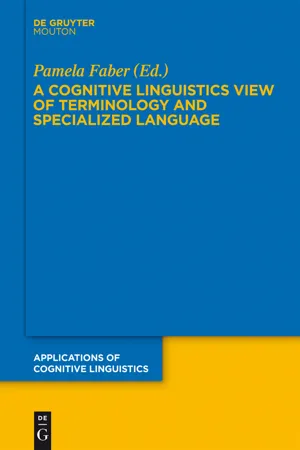
- 321 pages
- English
- PDF
- Available on iOS & Android
A Cognitive Linguistics View of Terminology and Specialized Language
About this book
This book explores the importance of Cognitive Linguistics for specialized language within the context of Frame-based Terminology (FBT). FBT uses aspects of Frame Semantics, coupled with premises from Cognitive Linguistics to structure specialized domains and create non-language-specific knowledge representations. Corpus analysis provides information regarding the syntax, semantics, and pragmatics of specialized knowledge units. Also studied is the role of metaphor and metonymy in specialized texts. The first section explains the purpose and structure of the book. The second section gives an overview of basic concepts, theories, and applications in Terminology and Cognitive Linguistics. The third section explains the Frame-based Terminology approach. The fourth section explores the role of contextual information in specialized knowledge representation as reflected in linguistic contexts and graphical information. The final section highlights the conclusions that can be derived from this study.
Frequently asked questions
- Essential is ideal for learners and professionals who enjoy exploring a wide range of subjects. Access the Essential Library with 800,000+ trusted titles and best-sellers across business, personal growth, and the humanities. Includes unlimited reading time and Standard Read Aloud voice.
- Complete: Perfect for advanced learners and researchers needing full, unrestricted access. Unlock 1.4M+ books across hundreds of subjects, including academic and specialized titles. The Complete Plan also includes advanced features like Premium Read Aloud and Research Assistant.
Please note we cannot support devices running on iOS 13 and Android 7 or earlier. Learn more about using the app.
Information
Table of contents
- 1. Introduction
- 2. Basic concepts
- 3. Terms as specialized knowledge units
- 4. Contextual information in specialized knowledge representation: linguistic contexts and images
- 5. Conclusions
- 6. References
- Thematic index
- Author index